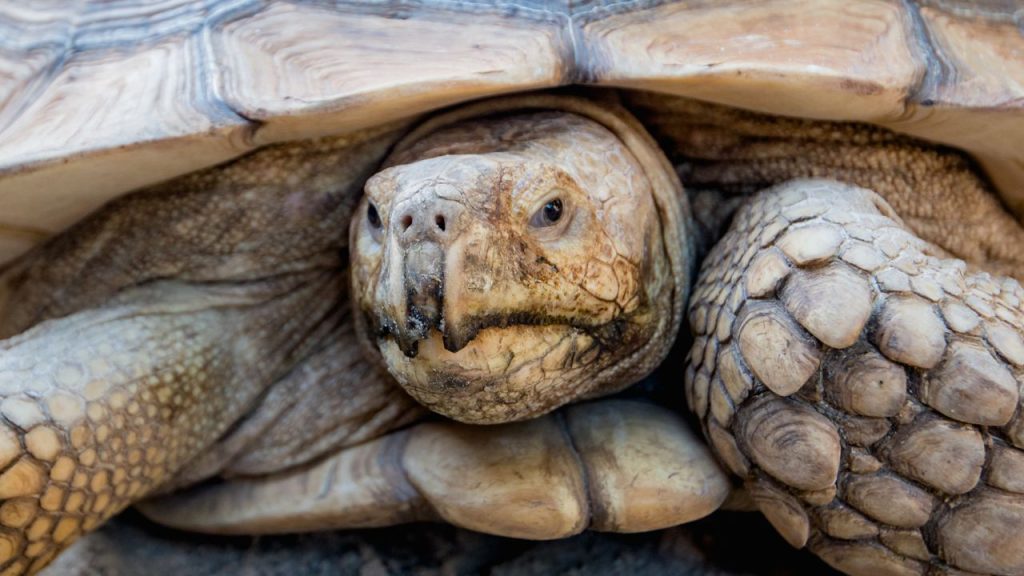Tags:
8 Signs A Tortoise Shows When It’s Stressed [Must Read]


fact checked & review by
Dr. Partho Kumar Shaha
Veterinarian (DVM)
The information is current and up-to-date in accordance with the latest veterinarian research.
Unfortunately, most keepers are still unaware of the mental illness of tortoises. Yes, these innocent pets may also fall victim to neurological disorders. Knowing the signs of mental stress and anxiety helps you diagnose the issue quickly and take action accordingly.
Symptoms of a stressed tortoise are inactivity, loss of appetite, less basking pattern, etc. Besides, the pet spends the day hiding and shows aggression to the owner and tank mates. In some cases, the sick tortoise experiences labored breathing, shell deformation, and even respiratory issues.
Take a dig at the below article for more information.
Key Takeaways
- A stressed tortoise shows physical and behavioral changes. For example, weak growth, inactivity, frequent hiding, less appetite, etc.
- An improper care sheet is mainly responsible for such mental instability in tortoises.
- Chronic stress can cause permanent damage to tortoises and may even kill the pets.
How To Tell If A Tortoise Is Stressed?
I don’t know why keepers find it hard to detect stress or anxiety in tortoises. In reality, they do not know what to look for.
Generally, a stressed tortoise exhibits behavioral and lifestyle changes. If you are close to your pet, there is no way you can overlook those hints.
Anyway, I am listing all the possible signs a tortoise shows when it is anxious for your convenience.
1. Less Participation In Daily Activities
Honestly speaking, tortoises live quite an active day. I sometimes spend hours watching my pet tortoise play with a toy or climbing the rock.
Apparently, tortoises with a physical disease or stress do not participate in such games. Instead, the pets show excessive lethargy. You may spot your tortoise sitting in the same spot all day long.
If tortoises rest for longer hours, something is definitely wrong with them. Look for other signs along with inactivity to confirm the disease. Keep in mind that stress and anxiety can be at the root of this condition.

2. Spend The Day Hiding
When building a tortoise enclosure, you must plan for several hiding spots. These pets can be shy and prefer a safe place to defend themselves. Usually, tortoises take shelter in a hiding spot when they are mentally drained or under attack.
Frequent handling, too much noise, and the sight of predators often make a tortoise hide behind rocks or in the vegetation. Well, this is an occasional behavior from the pet.
However, tortoises seem to hide more frequently than usual when under stress.
A gravid tortoise also spends the majority of her day hiding from sight. But she exhibits different behavior along with it. For example, digging nests, leg wiggling, etc.
3. The Pet Shows Unnecessary Aggression
Have you noticed how agitated you feel when angry or stressed? It is no different with tortoises too. If stressed, the creatures often lose their calm and act aggressively at the owner or tank mate.
Of course, anxiety is not the only thing that triggers hostile nature in tortoises. But all I am saying is to consider the mental instability if your pet is acting violently.
As per experts, stressed tortoises often make chirping noises. Likewise, these pets may do hissing and squeaking when aggressive. Click here to explore all the weird sounds tortoises make, along with their meanings.
4. Eat Less Than Usual
A healthy tortoise never says no to meals. In fact, sometimes, these reptiles end up overeating. However, the scenario is quite the opposite for sick or stressed tortoises.
In my previous post, I discussed 10 potential health issues in tortoises. Loss of appetite is a common symptom in all those diseases. You can go through the write-up and compare the illness signs to your tortoise for diagnosis.
If none of the conditions fit the tortoise’s profile, the pet is likely to be stressed. Professionals suggest a tortoise in panic or anxiety will not touch any meals. In fact, they will refuse their favorite sweet fruity treats.
The ideal feeding routine for tortoises is 5-days-a-week. Again, some healthy adults prefer a 7-days meal. Investigate the pet’s physical and mental condition if you notice any irregularities in the meal schedule.
Well, a hibernating tortoise may also refuse to eat. But that occurs due to the temperature drop. So, rechecking the enclosure temperature will confirm your doubt about this. Moreover, you can read this article to learn more about a hibernating tortoise.
5. Refuse To Drink
Tortoises are definitely not a fan of water like turtles. But they need a water source in the pen for soaking, drinking, and releasing body waste.
Water is far more important than meals for these reptiles. See, a tortoise may go months without food. But the creature can survive a maximum of a week or two without water.
Apparently, a stressed tortoise also refuses to drink water or take a bath besides avoiding food. I know it is difficult to determine how often your pet drinks water every day. But you can look for the signs of dehydration for confirmation.
Weight loss, sunken eyes, shrunk body, wrinkled skin, etc., are indications that your tortoises do not drink enough water. You must investigate the root of this dehydration and make necessary arrangements to reverse the condition.
As mentioned, stress can cause dehydration in tortoises. In such cases, the pets start drinking water daily and are interested in regular soaks once relaxed.

6. Change In The Basking Habit
The healthy basking hours for tortoises are 10 to 12 hours. Experts suggest keeping the bulb on for 14 hours in some chilly regions. Tortoises usually come under the lamp occasionally to bask in the heat.
It is evident that a stressed tortoise feels insecure and looks for hiding shelters. Moreover, the reptile barely comes out to bask. Therefore, expect an inactive behavior from the reptile.
7. Abnormal Shell Conditions
It may sound weird but mental health has a direct or indirect connection to tortoises’ shell condition. Reports say stress can trigger unhealthy skin or shell shedding. Besides, skin redness, drying, and lesions are also side effects of anxiety.
Wait! It does not end here.
You have seen how stress demotivates a tortoise to bask and eat properly. As a consequence, the creature suffers from mineral or calcium deficiency. Therefore, shell and deformation are observed in mentally unstable tortoises.
8. Additional Issues
Some more signs indicating stress in tortoises are,
- Labored breathing
- Wheezing noise
- Weight loss
- Dull or cloudy eyes
Why Is Your Tortoise Stressed?
As a responsible keeper, you must know what causes your tortoise mental discomfort. It helps you treat stress and anxiety in the pet. Furthermore, you can also remove the stress factors as a preventive measure.
14 reasons that trigger stress in tortoises are,
1. Too Much Of Everything!
Tortoises prefer a quiet and calm place over chaos. So, placing the reptiles in a room full of noise is a deal breaker. You may notice the pet hiding in the shell or burrow to escape the noise.
Likewise, do not allow too much light into the enclosure, as it will disturb the tortoises. For example, these pets need dark surroundings to sleep. No wonder why they keep their eyes closed to avoid any excess brightness. Therefore, installing a night light or lamp will only stress the pets out.
2. Improper Temperature In The Pen
Like turtles, tortoises can not function properly without a heating source. You can witness this phenomenon at the beginning of the winter. The drop in the temperature forces the pets to slow their metabolism and stay inactive.
Yes, hibernation is a natural process for tortoises. But shutting down the biological system due to unwanted temperature fall can be stressful for them.
In short, improper temperature arrangements will make the tortoises mentally and physically suffer. Sometimes, the tortoises experience stress and anxiety even with a quality heating bulb.
In such cases, the installation angle of the lamp is not appropriate to create a temperature gradient. As a result, tortoises can not find the perfect temperature point in their habitat. It can easily make the pets agitated and anxious.
3. Low-Quality Uv Lamp
UV bulbs are equally important for tortoises, just as heating lamps. While the UVB rays promote healthy bone and shell growth, the UVA influences mental stability in pets.
Professionals suggest that reptiles need sufficient UVA exposure to stay chilled and relaxed. It means a lack of UVA rays will definitely make the tortoises stressed.
Similarly, lack of UVB rays causes bone and shell deformation in tortoises. Such diseases make the pets physically vulnerable and trigger anxiety in them.

4. The Pen Is Too Dry
Tortoises do not like a dry environment at all. In fact, depending on the species, these creatures require a humidity percentage of 60 to 80.
A dry surrounding leads to dehydration, flaky shell, and skin diseases in the pets. As I have said, any illness is enough to make a tortoise anxious and stressed.
5. No Hiding Spot
Hiding places are a must in any tortoise’s enclosure. The pet will shelter in those spots whenever they feel threatened or stressed. The absence of a hiding shelter will only make the tortoise irritated.
Likewise, a burrowing heap is also necessary for the tortoise. This species is known as a natural burrower. The creature digs down the soil to cool off the heat, hide from others, or just for fun. If the enclosure lacks a burrowing ground, the pet will be really pissed and stressed at the surroundings.
6. The Pet Is Dehydrated!
Of course, dehydration is a curse to tortoises. It can lead to more complex and severe diseases in these pets. For example, renal dysfunction, bladder stone, etc.
Consequently, dehydration will be responsible for stress in tortoises too. Learn more about a dehydrated tortoise from this link.
7. A Congested Habitat
Tortoises can be small or medium but require a spacious habitat to thrive. Putting the pets in a crowded enclosure will only make them stressed. Besides, a congested tank hampers the growth of the tortoises too.
8. Overcrowded Tank
Well, it is possible to raise multiple tortoises in a single enclosure. Also, depending on the species, you can put tortoises with other reptiles too.
But there is a huge drawback of community habitat. In most cases, tortoises act as a bully and pick on other tank mates all the time. Not to mention the fights you witness in the enclosure over territory and food. Such a lifestyle can stress the young and weak tortoises.
9. Overfeeding Or Underfeeding
What if you do not feed your tortoise enough? What happens, then?
Of course, the pet will suffer from malnutrition and grow weaker. What else?
Professionals suggest that a regular meal system can relax the tortoises. Thus, underfeeding not only makes the pets physically weak but also triggers anxiety in them.
Likewise, overfeeding can also be a stress factor in tortoises. As you know, allowing reptiles vigorously leads to obesity. An overweight tortoise always feels stuffed and fails to perform regular tasks. Hence, self-insecurity and mental instability are common in the pet.
10. Any Accidents?
Stress in tortoises can be a secondary phenomenon. For example, a fall from a height or a predatorial attack may cause the pet mental trauma. Generally, the victims take days and sometimes weeks to recover from the shock.
11. Frequent Handling
Tortoises may be friendly to the owners but are not as social as your cats and dogs. So, think twice before reaching out to pet your tortoises. These creatures hate frequent human touch and often count it as a threat.
In fact, frequent handling is the most common reason that makes a tortoise stressed.
12. Anything New!
Well, tortoises are not big fans of change. No wonder the pets refuse to eat and hide inside the shelter after you welcome them to a new home. They act weird because the unfamiliar surroundings make them stressed and anxious.
The same incident occurs when you transport the tortoises from one place to another. These pets are not yet comfortable with the motion. Hence, transportation might trigger anxiety in them.

13. It’s All About The Female Tortoises
The male tortoises behave aggressively as the mating season approaches. In fact, they ram the females violently during the copulation. Though it is natural for males, such acts can stress out females and make them physically injured.
Moreover, stress and anxiety are most common in gravid tortoises. It is mostly the hormones that bring such behavioral change in the pets.
14. A Glass Tank Set Up
Tortoises are not a fan of transparent glass habitats. The creatures get confused when they see through the glass and want to explore the outside world. You may catch a tortoise pushing the wall in an attempt to get out of the pen.
Failing to escape can easily stress the pet and trigger anxiety. Therefore, you must arrange an opaque or plastic tank for your tortoise.
7 Tips To Minimize Stress In Tortoises
You can not let your tortoises live with trauma. Otherwise, they will grow weak and live a reduced lifespan. Here is how you can manage stress in your tortoises,
1. A Proper Care Sheet
A fool-proof care guide is enough to keep the tortoises mentally fit. My recommendations are,
- Arrange a spacious tank with a big basking dock for the pet.
- Install a heating lamp and a UV bulb in the enclosure.
- The basking temperature should be between 90 to 105F.
- There must be a temperature gradient present in the tank. For example, the warmer and cooler sides should be between 75 to 90F and 65 to 75F, respectively. Access a temperature guide for tortoises from here.
- You must ensure the pets have a balanced meal with high fiber and low protein. Add calcium supplements to the diet to back up any mineral deficiency.
- Following a 5-day-a-week meal routine is okay for adult tortoises. Some pets want to be fed every single day, which is healthy too.
- Place the water source in an accessible position in the enclosure to ensure proper hydration.
2. Keep The Tortoises Entertained
A boring life often leads to stress and anxiety. It is why you must arrange entertainment sources for your tortoises. Get push toys or place rocks in the enclosure. Both climbing and walking are fun activities for these pets.
Get fun toy ideas for tortoises in this article.
3. Remove Any Disturbance
I have already mentioned that tortoises get irritated by excess light or noise. So, you must build the habitat in a quiet room and remove the sources of extra lights.
4. Consideration For A Tankmate
Though tortoises can live with a companion, it is not always recommended. Adult males are often a bully and pick on the young and females. Not to mention the males also get involved in fights with each other.
Hence, never house an adult male tortoise with another male, female, or baby. Of course, you may have to put the male and female tortoises together during the breeding process. In such situations, add more females against one male to reduce the damages.
Furthermore, separate the tank mates immediately if you notice any fight or violent activities. Finally, ensuring a large enclosure with sufficient resources can also minimize the aggressiveness of the pets.

5. Enough Hiding Spots
You already know how significant hiding spots are for tortoises. Therefore, add large, smooth rocks and broad-leaf plants to the enclosure. These work as hiding shelters for pets.
Moreover, tortoises may also burrow to escape any mental trauma. Hence, you must build a burrowing spot for these creatures in the pen.
6. Minimum Handling
Less interaction with the tortoises is always better. So, try not to touch the pets unnecessarily.
Sometimes, you will watch the tortoises stressing over silly things. Do not try to comfort them, as it can backfire. Instead, leave the creatures alone.
7. Extra Care
A sick tortoise deserves special care, just like a gravid tortoise. If you find your pet to be ill, start the treatment immediately. Sometimes the stress is just a result of an underlying disease. You can always talk to a vet if necessary.
Are There Any Physical Side Effects Of Stress To Tortoises?
Chronic and untreated stress can cause serious physical damage to the tortoises. For example,
- Tortoises will experience weak immunity and fall sick to more diseases.
- The female gravid tortoises may refuse to lay eggs if they are too anxious or panicked.
- A stressed tortoise will never reach a healthy shell size and overall growth.
Can Stress Kill A Tortoise?
Honestly, stress can not directly kill your tortoises. But yes, if you do not take action to relax the pets, it can definitely cost them their lives.
For example, stressed tortoises often avoid food and stay inactive. It will weaken the pets’ immunity and make them vulnerable to more complex diseases. As a consequence, your tortoises may have a reduced lifespan.
Reportedly, there are cases of tortoises dying due to chronic stress.
Before You Go…
Do you know tortoises always drop signs for any behavioral and physical changes? For example, a gravid tortoise will show specific symptoms during the gestation and nesting period. The linked article talks more about this topic.
How To Tell If Your Tortoise Is Pregnant

About Author
Muntaseer Rahman started keeping pet turtles back in 2013. He also owns the largest Turtle & Tortoise Facebook community in Bangladesh. These days he is mostly active on Facebook.
Disclaimer
This site is owned and operated by Muntaseer Rahman. TheTurtleHub.com is a participant in the Amazon Services LLC Associates Program, an affiliate advertising program designed to provide a means for sites to earn advertising fees by advertising and linking to Amazon.com. This site also participates in other affiliate programs and is compensated for referring traffic and business to these companies.
